Comparing the Top 15 Restream Alternatives for Multistreaming in 2025
Restream is a leading live streaming software enabling users to broadcast content across multiple platforms simultaneously. It simplifies multistreaming, making it an ideal choice for content creators, businesses, and broadcasters looking to expand their reach. However, while Restream offers plenty of features, exploring Restream software alternatives could be beneficial for those seeking different functionalities or budget options. Multistream alternatives such as Castr, Videolinq and StreamYard cater to different streaming needs and budgets.
In this post, we cover everything broadcasters need to know about the Restream service and compare it to other professional video hosting platforms such as Dacast. We’ll also discuss the features of 15 Restream alternative platforms that you can use for multicasting and similar broadcasting functions. By the end, you’ll have a clear idea of Restream and its alternatives so you can make an informed decision on the most suitable streaming solution for you.
Streaming platforms software companies update their pricing and capabilities regularly. We’ve updated this post with the most recent information for the top Restream.io competitors as of February 2025.
Table of Contents
- What is Restream?
- Restream vs. Dacast: A Comparison
- Shared Features Between Restream and Dacast
- How is Dacast Different?
- How is Restream Different?
- Can Restream Be Used on Its Own?
- Comparison of The 15 Best Restream Alternatives in 2024
- When to Use Restream Alternatives
- FAQs
- Conclusion
What is Restream?
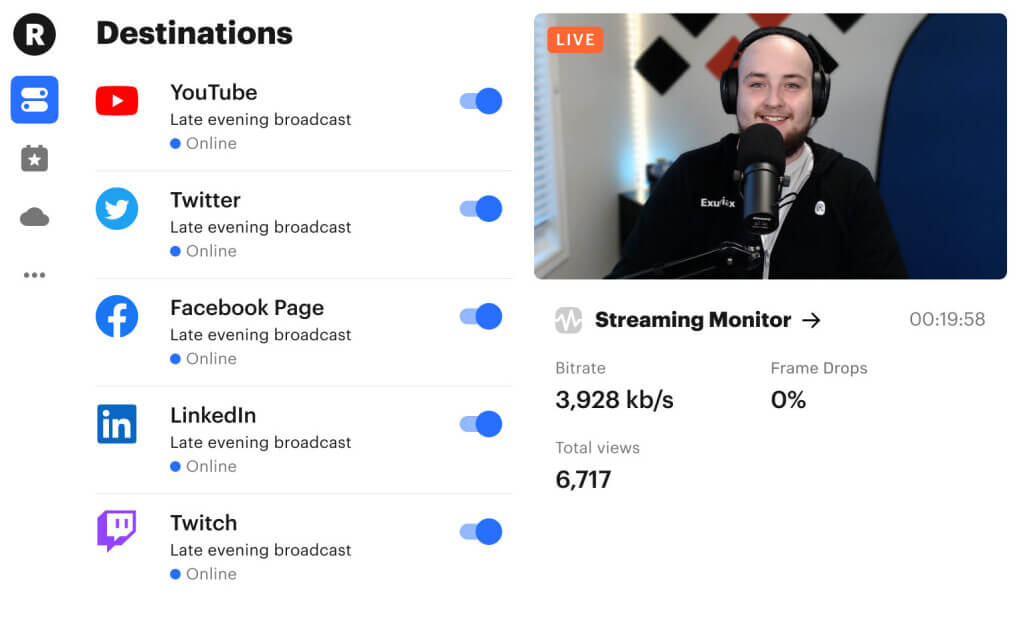

Restream is a top live video streaming software that facilitates multistreaming or simulcasting. This allows users to broadcast content across multiple platforms simultaneously. This powerful tool has been a game-changer for content creators, businesses, and broadcasters aiming to maximize their reach.
Restream integrates with popular social media platforms such as YouTube Live, Twitch, Facebook, Twitter, and TikTok. Also, it supports live streaming to over 30 platforms including LinkedIn Live, Twitter, and Mixer, broadening audience engagement and traction potential.
One of Restream’s standout features is its cross-platform analytics. This consolidates data from all streaming destinations into a single dashboard. This comprehensive view helps users monitor performance metrics and understand audience behaviour for a refined content strategy. This helps broadcasters make more effective decisions and further improve their reach.
Also, Restream’s web-based platform accommodates various streaming setups. And its dedicated Restream mobile app ensures flexibility and convenience for users on the go. However, while Restream is a leader in its field, it faces growing competition from other Restream competitors such as StreamYard, OBS Studio, and Wirecast. These alternatives offer different features and price points which cater to a wide range of streaming needs.
Overall, Restream is a simulcasting platform that’s changed the game. Offering extensive platform integration, analytics, and versatile streaming options, it’s a great tool for digital broadcasters.
Restream is for both individual creators and larger organizations, starting with a free option and ranging to a business plan that costs $199/month.
Restream vs. Dacast: A Comparison
Restream and Dacast are two valuable tools for broadcasters. As we mentioned, Restream is a video streaming software with limited video editing capabilities. Dacast, on the other hand, is a video hosting software.
These platforms have a bit of overlap in features, but they each have a different function in the live streaming process. That said, Dacast is not a Restream alternative but more of a Restream complement.
Shared Features Between Restream and Dacast
As we mentioned, Restream and Dacast have several live streaming features in common. Let’s take a look at the offerings that both platforms share.
Simulcasting
Simulcasting, which is also called “multistreaming,” is a very valuable tool for broadcasters. It is what allows you to maximize your viewership by broadcasting your stream to multiple channels simultaneously. reaching a larger audience .
Since Restream is a multistreaming platform, its simulcasting feature is its strength. Broadcasters can share their streams on dozens of streaming platforms at a time, including Facebook, YouTube, Twitch, Twitter, LinkedIn, and more.
Like Restream, it’s entirely possible to do simulcasting through Dacast. In fact, you can simulcast to popular platforms like Facebook, YouTube, and Twitch. You can also simulcast to any other RTMP destination of your choice from within Dacast. All you have to do is create a new stream or choose an existing one. Then, head to the engagement tab and look for “Simulcast.” You can then connect individual platforms by entering the stream key that Dacast provides.
Live Streaming
Both Restream and Dacast are capable of hosting live streams. However, each company approaches this a little differently.
Live streaming is one of the main offerings from Dacast, so our platform is equipped with powerful tools for conducting live broadcasts. Restream, on the other hand, only supports in-browser live streaming.
If you are looking for a robust live streaming platform, Dacast has what you need, including features such as:
- Robust content delivery network
- End-to-end low latency video streaming
- Video streaming security options
- Video monetization with an integrated worldwide paywall
Stream Scheduling
Broadcasters can schedule streams ahead of time with both Restream and Dacast. On Restream, you can upload a video to be played at a particular time.
With Dacast, you can upload a video and schedule it to play at a specific time as well. You can also pre-schedule content that’s streamed live, allowing you to share the URL and embed the video on your own website and social media platforms before the live stream begins.
That is an excellent marketing feature because it allows you to attract a bigger wider audience to the exact live stream link and stream directly. That way, viewers don’t have to search for the link on the day off. Instead, they bookmark your page ahead of time and simply click to view.
Dacast also offers the option to showcase a countdown timer before your live stream begins.
Video Analytics
Both Dacast and Restream offer powerful video analytics tools. It’s quiet This comes in handy for businesses and creators that want to track their audience’s behavior and assess the performance of their videos. Analytics is especially beneficial for sales and marketing.
On Dacast, analytics reports provide information on concurrent viewers by time, plays by time, playtime per time, and plays by location.
On Restream, you can see which platform brings the most traffic to your stream and a chart of viewership trends throughout a stream. Restream also produces analytics on audience trends and preferences.
White-Label Streaming
White-label streaming is important for broadcasting at the professional level because it allows broadcasters to remove distracting third-party branding. Fortunately, both Dacast and Restream support white-label streaming through an HTML5 video player.
Please note that Dacast offers white-label streaming on all plans, but Restream does not. In addition to white-label streaming, Dacast also offers API access, allowing for full customization of your video player experience.
HD Streaming
Both platforms support HD streaming, which means that they are both good options for delivering high-quality broadcasts to your customers. The ability to stream in HD can help maintain a great user experience.
It’s especially beneficial for e-commerce and retail businesses that use live streams to host videos, auctions or showcase their products. Showing your viewers your products’ minute details can increase sales and your audiences’ confidence in your business.
Low Latency Streaming
Video latency is the delay between the time a video is captured and the time it reaches the viewers. Both platforms are capable of low latency streaming, but Restream may add as much as 2 seconds of extra latency.
Dacast has invested in tools to ensure that they can provide you with the lowest latency possible. That means when you are live sharing a live stream, viewers are seeing the video as close to when it was recorded as possible.
Low latency is usually a good thing, but some users prefer some delay. That’s because latency can serve as a grace period if the network goes down on the broadcast’s end, or another issue interrupts the live stream.
A few seconds of delay can ensure that your viewers continue to watch the stream while your network starts back up, which usually takes a few seconds.
Live Chat
The live chat tool on Restream is one of the most notable features of the platform.
With the live chat tool on Restream, you can bring all of your chats from every platform you are streaming on together in one place. With simulcasting, having all your chats together in one place makes it easier to manage the chat experience for all of your viewers.
They also have tools that allow you to call out viewers’ comments live during the chat, showcasing them on the screen. This is a great way to increase viewers’ engagement in your streams.
Dacast also recently rolled out a live chat tool with the help of a new partnership with RumbleTalk.
RumbleTalk is a third-party app you can download and connect to your stream that is supported by Dacast.
RumbleTalk offers a wide range of features, such as:
- Live polls
- Live moderated Q&A
- Monetization options such as donations, payments, and paywall
- RESTful API
- Customize Chat Design
- Private chat conversations
They offer a range of tools that help you control and monitor your chats, such as:
- Slow down chat option
- Approve chat messages before going public
- Mute users
When you open your live stream up to comments, you need to moderate them as well. If you are getting more comments than you can respond to, then you should slow down the chat, allowing users to only send a limited number of chats per minute.
If certain users are distracting you from conducting the live stream, then you can mute them. You can also approve all messages before they go public. These tools allow you to control the live chat experience on your professional live streams.
Streaming Protocols
Several protocols make live streaming possible. RTMP is a protocol that is important for both Restream and Dacast. Both of these platforms use RTMP ingest as a primary ingestion method, which means that they work with RTMP encoders and other RTMP-compatible sources.
WebRTC is a protocol that is relevant to both platforms because it is the protocol that makes webinar-style streaming and web conferencing possible. Dacast integrates with Zoom to bring web conferencing functionality to users, and Restream allows up to 10 broadcasters to present at once with a similar format.
SRT is another necessary protocol for broadcasting. It is what makes streaming from the browser possible.
Both Restream and Dacast offer in-browser streaming.
What does that mean? You can start a stream using your web browser, and stream directly from the integrated webcam on your device. You don’t need any fancy setup or equipment to start live streaming this way. In-browser web streaming makes streaming simple and straightforward.
How is Dacast Different?
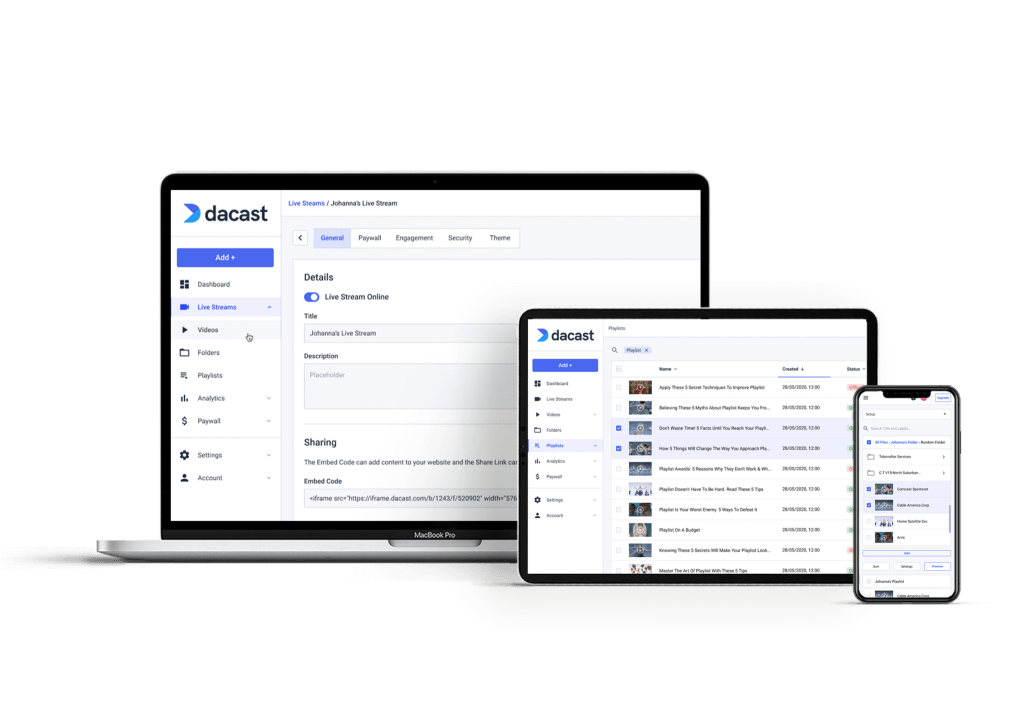

Dacast is an end-to-end professional video hosting platform, so its offerings are a bit more advanced than Restream. This is not to say that it is better than Restream, it just has some different functionalities.
Since Dacast is a video hosting platform and video content management system (CMS), it is fully equipped with the tools that broadcasters need to store, manage, organize, and deliver video content.
With Dacast, broadcasters can monetize their video content with subscriptions, advertisements, or pay-per-view with the help of a secure paywall. Video players are customizable with easy-to-use standard settings and player API.
Dacast users also have access to advanced video security features, including low latency streaming, password-protected live streaming, DRM, tokenized access, IP/geographic restrictions, domain/referrer restrictions, and AES video encryption.
Dacast’s customizable HTML5 video player is easy to embed on any website or app and many social media platforms. If you want to launch your video business, that is possible, too. Dacast Expos allow you to set up a viewer-facing video gallery in just a few clicks.
Dacast also has 24/7 customer support that you can access via email, chat, or over the phone, depending on the type of plan you have. With live events, you need a support team that can help you with any issues that arise at the moment.
Dacast is a robust video hosting service that allows you access to a full range of tools for live streaming and video-on-demand hosting. With Dacast, you can create a custom experience for your viewers.
How is Restream Different?
Restream is designed to complement platforms like Dacast, so naturally, there are a few differences to note.
First, the main purpose of Restream is simulcasting support. While Dacast has simulcast streaming capabilities, those are not as vast as the ones you get on Restream because Restream makes it possible to stream to over 30 platforms at the same time. Dacast can stream to a small handful without the support of any external tool.
Another major difference is that Restream’s live streaming tools are only supported in-browser rather than with a downloadable program.
Something else that Restream offers that Dacast does not is video editing. Restream has an online live streaming studio that helps broadcasters add backgrounds, overlays, and more. Again, Dacast has some limited support for overlays and such, but Restream has access to more creative tools.
Last but not least, Restream offers a built-in chat tool. This allows broadcasters to add a chat room to their live streams. This is great for getting viewers involved and promoting engagement.
Can Restream Be Used on Its Own?
By now, you’ve likely gathered that it doesn’t have to be an “either/or” situation when it comes to Restream and Dacast. The two platforms can be used together.
In fact, Restream does not support video hosting, so you need to use it alongside professional hosting software. We recommend storing and managing your videos on a platform like Dacast and using Restream to tap into those additional features.
Dacast supports integration with Restream, allowing you to access and use the tools of both of these software platforms at the same time. Restream works best when used with a full video hosting service such as Dacast, which offers a range of robust video tools and support.
Comparison of The 15 Best Restream Alternatives in 2025
Restream is regarded as an impressive simulcasting and live chat tool. Still, if it’s too sophisticated for you or you’re looking for some specific features that it doesn’t have, then you should know that there are quite a few worthy alternatives and competitors on the market that you can use.
Here are 15 platforms and tools to consider instead of Restream: Let’s take a look at a few of Restream alternatives.
1. Wirecast
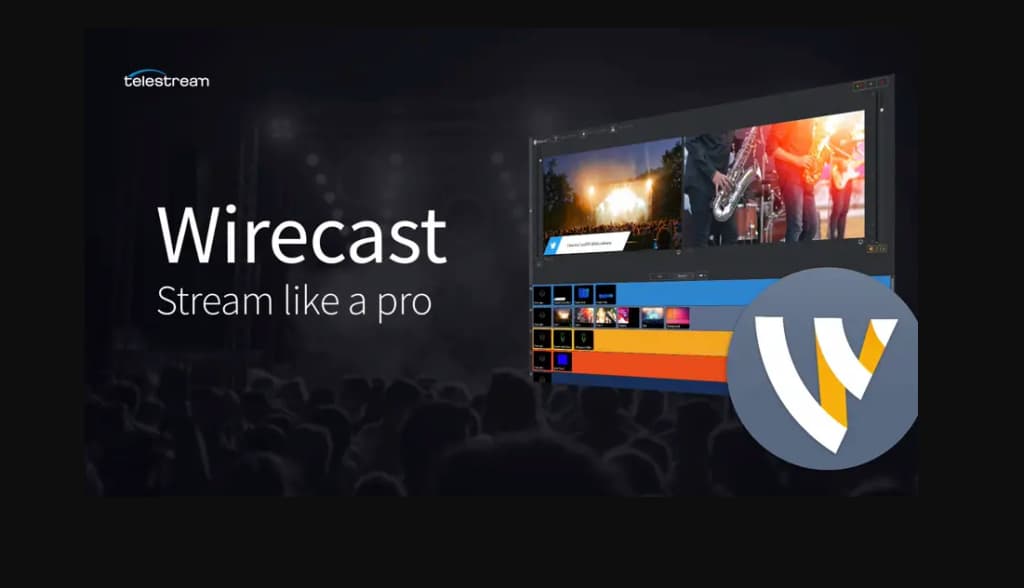

Let’s begin by first comparing Wirecast with Restream. Wirecast is a streaming software from Telestream and a powerful Restream alternative and competitor that supports live stream capture, editing, and streaming to an unlimited number of destinations.
The advantage of this platform over Restream is that it comes with several extra features, including auto-archiving, remote production, playlists and organization, access to a stock media library, and social media integrations.
Pricing:
This platform is a bit advanced, and its price reflects that. Wirecast comes in two tiers:
- Wirecast Studio for $41/month
- Wirecast Pro for $54/month
However, unlike Restream, this alternative doesn’t offer a free plan to help you multistream. That said, some of the best features offered by Wirecast include unlimited sources, automatic detection of NDI sources, conferencing, professional audio, and a stock media library. You also get social media integration to help you build moderated comment overlays on your streams.
Here are some more ways Wirecast is different from Restream:
- You can connect and control multiple cameras at a time
- The analytics feature isn’t as great as it is with Restream
- Wirecast has limited video monetization tools
- You can use Wirecast on Mac, Windows, iPad, and iPhone, while Restream is a web-based tool.
For more information on how to simulcast on Dacast through Wirecast, please check out our dedicated tutorial.
2. Switchboard Live
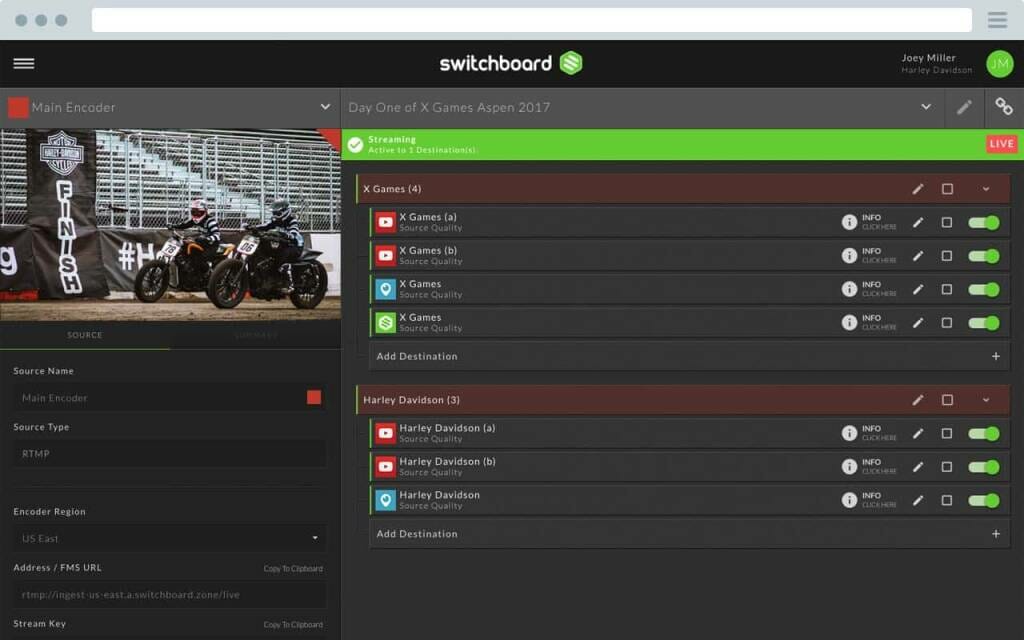

Switchboard Live is another reliable Restream alternative. It supports streaming to several destinations. It also has tools for video player embedding.
The most significant difference when comparing Switchboard vs. Restream is that Switchboard doesn’t have a live chat feature while streaming. However, it supports live polling, multi-camera feed, and video annotations, unlike Restream. You can also multistream to an unlimited number of destinations through Switchboard and can easily share the streams with your guest’s social media accounts without having to ask them for their passwords. You also get auto-starting features for several destinations so you don’t have to manually turn them on.
This platform is also not equipped with editing tools with a live streaming studio for editing. It is more basic than Restream and other alternatives covered in this list.
Here are some more ways Switchboard Live is different from Restream:
- It supports 1-10 users, whereas Restream supports 1000+ users
- Switchboard Live offers webinars, documentation, and videos to help you learn to navigate the interface and use the platform to the fullest
- It offers a video annotations feature
- You don’t have HD video streaming on Switchboard Live.
Switchboard Live has three different plans. For each plan, you’ll need to book a call to discuss pricing.
- Pro plan is $99/month
- SMB plan is $249/month
- Enterprise plan is custom priced
All of these plans support streaming to an unlimited number of destinations.
For more information on how to simulcast on Dacast through Switchboard Live, please check out our dedicated tutorial.
3. Castr
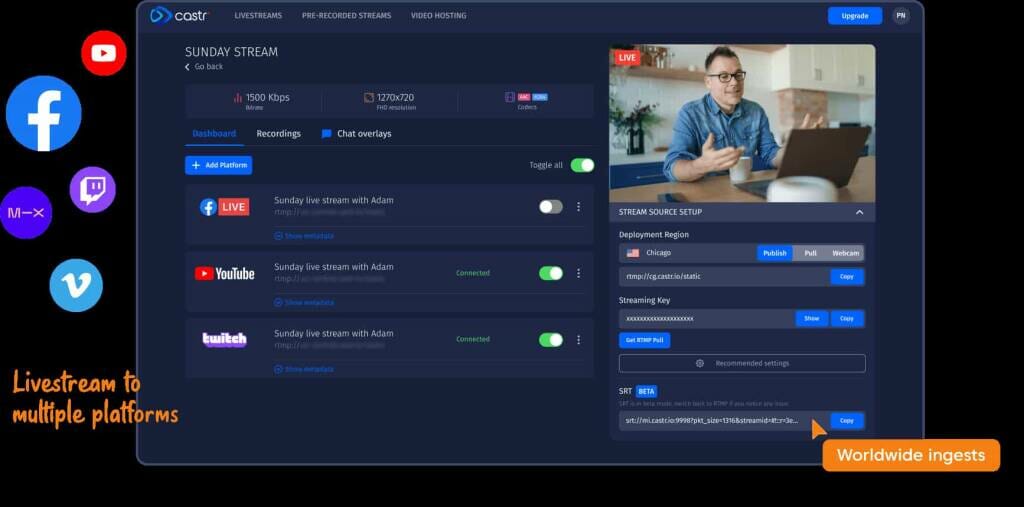

Next, let’s talk about Restream vs. Castr. Castr offers two products for broadcasters. One is a simulcasting tool that lets you stream to multiple destinations at once. The other is a live streaming and video hosting platform. There are separate fees for each of these products.
The Castr product that would be considered a Restream alternative is their simulcasting tool. What makes Castr different from Restream is that it offers multiple kinds of ingesting, rather than just RTMP ingest. The other types of ingesting that Castr supports are RTSP, HLS, and MPEG-TS.
Another unique thing about this platform is that it allows streaming to multiple Facebook pages, groups, and profiles simultaneously.
One of Castr’s most valuable features is 24/7 support. Additionally, all plans are white-label, so you don’t have to worry about any third-party branding distracting your audience.
Castr also enables you to multistream to 30+ destinations, much like Restream. You can seamlessly turn on streaming to different platforms with a simple toggle, making it very user friendly. However, this Restream competitor offers numerous other features like creating an OTT app, monetization features, video hosting, and more. That makes it more feature-rich than Restream.
Here are some more ways Castr is different from Restream:
- You don’t get a free version with Castr as you get with Restream
- You can’t connect multiple camera feeds to your stream when going live with Caster.
- You can’t split your screen in Castr nor add multiple screens
- There are no ads on any of Castr’s plans
- You get more monetization options in Castr as compared to Restream.
Castr has six multistreaming pricing plans, including:
- Starter: $19.99/month
- Standard: $39.99/month
- Professional: $99.99/month
- Premium: $149.99/month
- Ultra: $299.99/month
- Custom: Advanced plans are customized, so prices vary
Castr also offers a 7-day free trial on all plans.
4. Splitstream
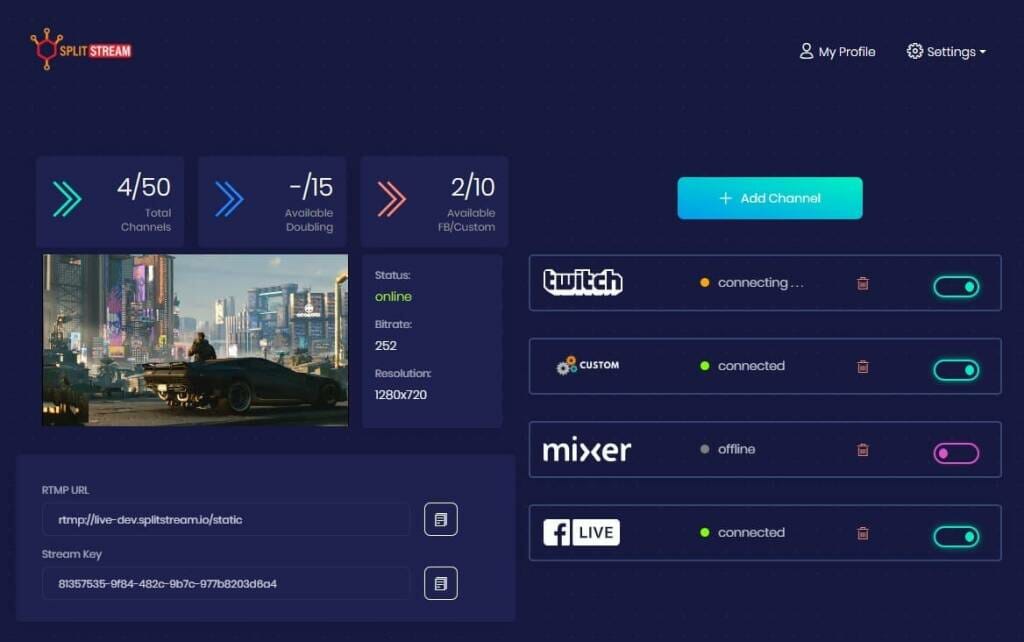

Splitstream is another simulcasting tool that is a worthy Restream alternative. This tool is pretty bare-bones, so it is best suited for broadcasters that need simulcasting tools, and only simulcasting tools.
It doesn’t offer a free trial or a free version. They offer basic free accounts plus three paid plans. These include:
- Standard: $9.99/month; supports streaming to up to 15 channels at once
- Pro: $29.99/month; supports up to 30 channels at once
- Pro+: $59.99/month and supports up to 50 channels at once
Since Splitstream has a free plan, it is a viable option for those that are seeking a free Restream alternative.
5. Prism Live Studio


Prism Live Studio is a Restream alternative that focuses primarily on video editing and production as opposed to simulcasting. This platform does support simulcasting, but it is not the primary function.
When evaluating Prism Live Studio vs. Restream vs. other Restream alternatives, consider that this platform is a bit more limited than the others. It only offers multicasting to YouTube, Twitch, Periscope, Facebook, afreecaTV, V LIVE, and NAVER TV.
Broadcasters can access Prism Live Studio on both mobile and desktop apps. No pricing is published on the site, but the app can be downloaded for free on the App Store and Google Play Store.
A great feature of this platform is that you can remove the watermark while live streaming. It offers a much higher video quality than other services in the same price range. You can also enjoy extra low latency with Prism Live Studio for free.
The other advantage of using this Restream competitor is that you can choose to hide your face behind virtual avatars. You can also share your screen with ease in up to 4K resolution. You also have the option to add various background filters, various effects, and masks.
6. Streamlabs OBS
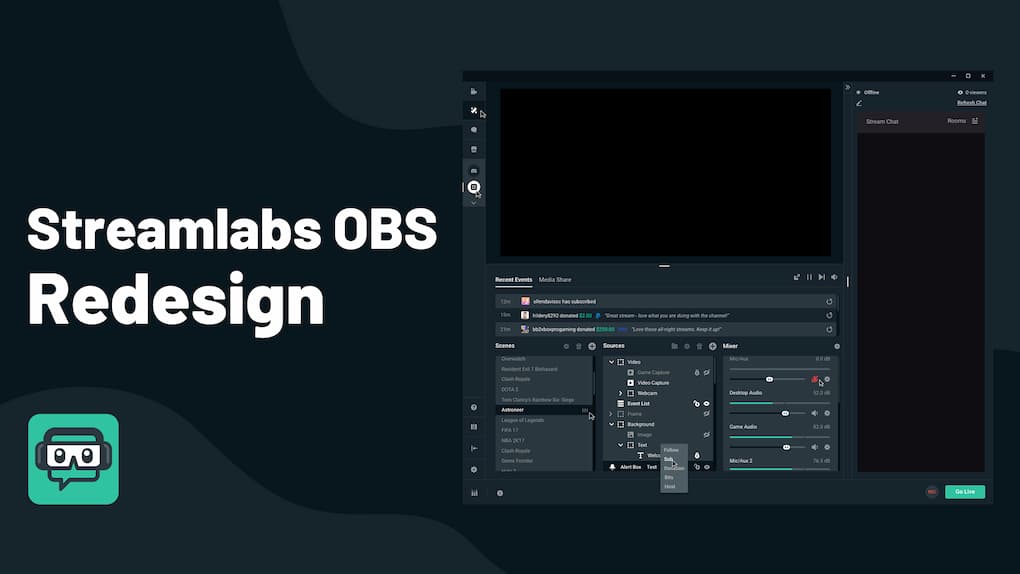

Here’s the rundown on Restream vs Streamlabs OBS. Streamlabs OBS is another streaming tool software that is very similar to Restream. It is fully loaded with a variety of live streaming tools, including simulcasting, video editing, graphic overlays, collaboration tools, and more.
Although Streamlabs OBS has many use cases, many of its users use it to stream computer games. The best part about Streamlabs OBS is also that it’s completely open-source. You can also get it for both Android and iOS devices.
This Restream alternative has an edge because it offers numerous branding tools, video editor, browser-based video recorder, merch store, and more. You can also install it on your consoles. It’s also possible to create a custom tip page and domain to help you generate revenue from multistreaming.
Here are some more ways Streamlabs OBS is different from Restream:
- Doesn’t offer a free trial
- Streamlabs OBS works on Windows and Mac, unlike stream
- You can get customer support via 24/7 live support and chat
- Streamlabs doesn’t support multiple camera feeds
- You can’t record your sessions on Streamlabs
- There’s no option to schedule your live event on Streamlabs.
Pricing:
Streamlabs Prime costs $19/month or $149/year. That said, the free plan does allow you dual output for up to 2 destinations. It also gives you 1 GB storage, branding tools, and more.
There is a free version of Streamlabs OBS, but to access simulcasting and other premium features, users must upgrade to Prime.
7. Resi
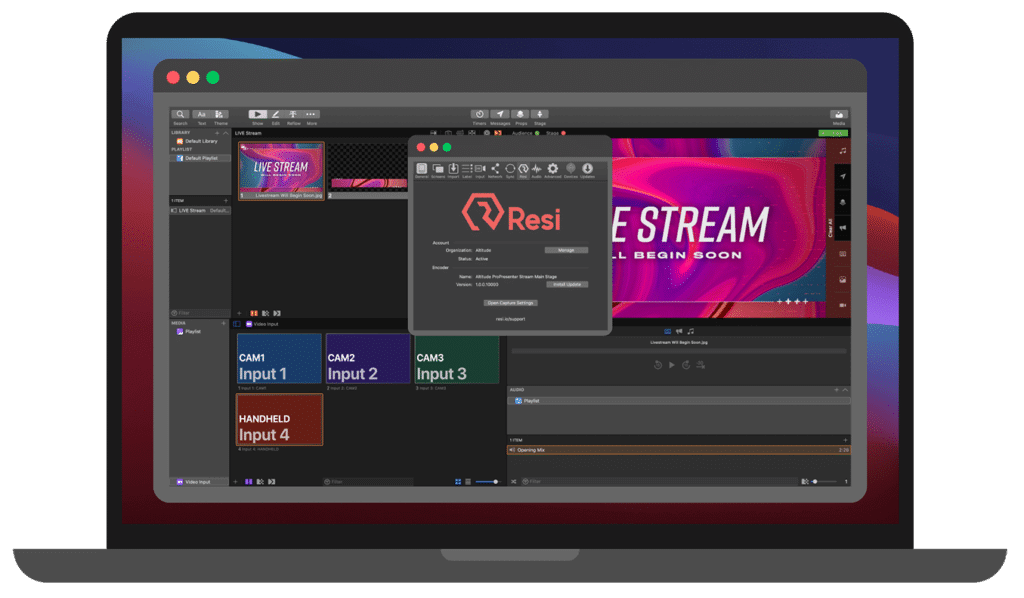

Resi is a streaming company with several unique streaming products. One of these products is a streaming software called Resi ProPresenter Stream, and this tool is certainly a viable Restream alternative.
Some of ProPresenter’s top features include simulcasting, one-click streaming, enhanced automation, scheduled stream replays, and built-in tools for encoding and switching.
What makes Resi’s products unique is that they use RSP as a transfer protocol rather than RTMP. This protocol was designed by Resi to improve the streaming experience for both broadcasters and viewers.
A key thing to consider when comparing Resi vs Restream is that Resi is known for its superior ongoing product support. Many people rave about how easy it is to do business with Resi.
This Restream alternative also offers live streaming and on demand content features. You also get the ability to upload pre-recorded content for live streaming and multistreaming to various platforms. Resi also enables you to get 1-2 channels of video and 16 channels of audio for multistreaming to help you deliver a superior experience to viewers.
Here are some more ways Resi is different from Restream:
- Doesn’t offer a free trial
- Resi has limited audience engagement tools
- You can’t put your own branding on the live streams on Resi
- You can’t record your sessions on Resi
- You can live stream via Resi on Windows, Mac, Linux, iPad, and iPhone.
Pricing information is not published on the Resi website, so interested users must submit a quote request for more information.
8. Videolinq
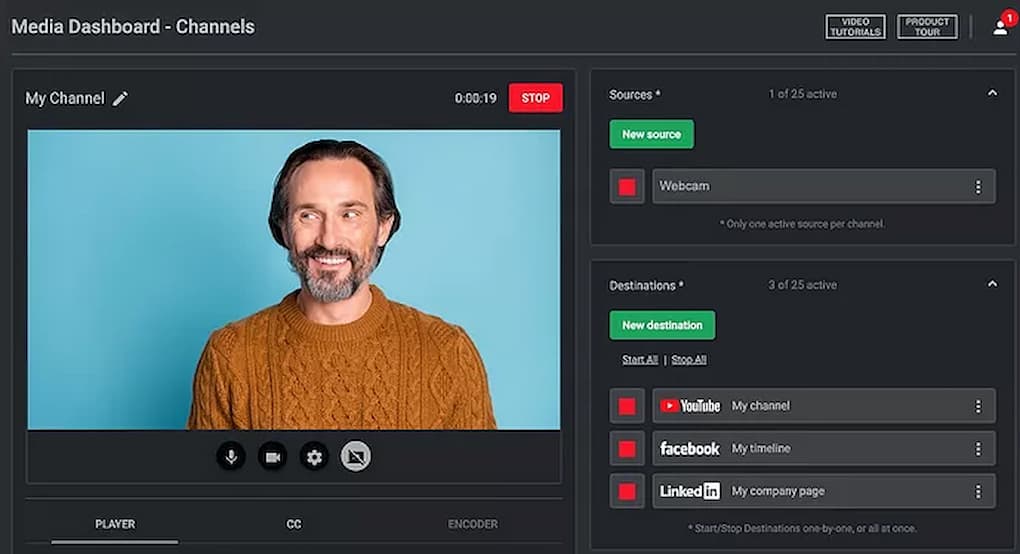

Videolinq is another top Restream competitor alternative that has a special focus on live stream production. It has a unique simulcasting tool that is complemented by tools for HD streaming, IP camera streaming, remote streaming, and smart OTT distribution.
There are a lot of similarities between the two platforms, but an important distinction to consider when comparing Videolinq vs. Restream is that Videolinq doesn’t offer Q&A functionality. However, it does offer video annotations, unlike Restream.
The distribution options offered by this Restream alternative area plenty as well. You can distribute to social media platforms, CDNs, and video platforms to boost your reach. It’s also possible to schedule your streams with its powerful time-zone broadcasting scheduler. Videolinq also provides streaming statistics to help you understand the impact of your multistreams.
This company also offers products for team collaboration, closed captioning, stream scheduling, and video player building.
Here are some more ways Videolinq is different from Restream:
- You can’t connect multiple camera feeds on Videolinq
- There’s no option to record your live streaming sessions on Videolinq.
Pricing:
Videolinq has three pricing plans, including:
- Pro: $99/month for streaming to 10 destinations
- Enterprise: Custom pricing
9. BoxCast
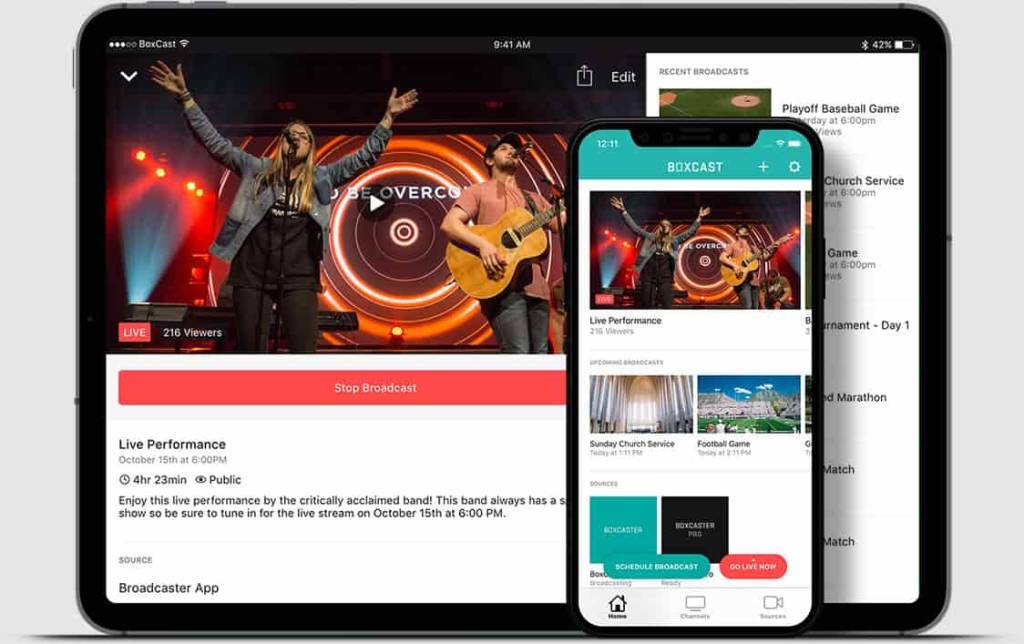

Most of the Restream alternatives we’ve covered focus on simulcasting and similar tools. But when it comes to BoxCast vs Restream, one key takeaway to consider is that BoxCast includes that functionality plus more advanced video hosting support.
BoxCast’s Broadcaster App provides a powerful alternative to Restream for broadcasters who are looking for one tool that does it all. This HD streaming app is capable of remote streaming, simulcasting, cloud transcoding, ticketing, broadcast monitoring, and scoreboard integrations.
Here are some more ways BoxCast is different from Restream:
- It has limited tools to engage with your audience as compared to Restream
- You can’t connect multiple camera feeds in BoxCast
- BoxCast offers good video monetization features
- You can set up your live stream on BoxCast from Windows, Mac, iPad, and iPhone.
Pricing:
There are four pricing options from BoxCast, including:
- Standard: $89/month
- Deluxe: $149/month
- Advanced: $249/month
All plans offer a free demo. Each plan also supports streaming to your website, different social media sites, all RTMP destinations, and smart TV apps.
10. SplitCam
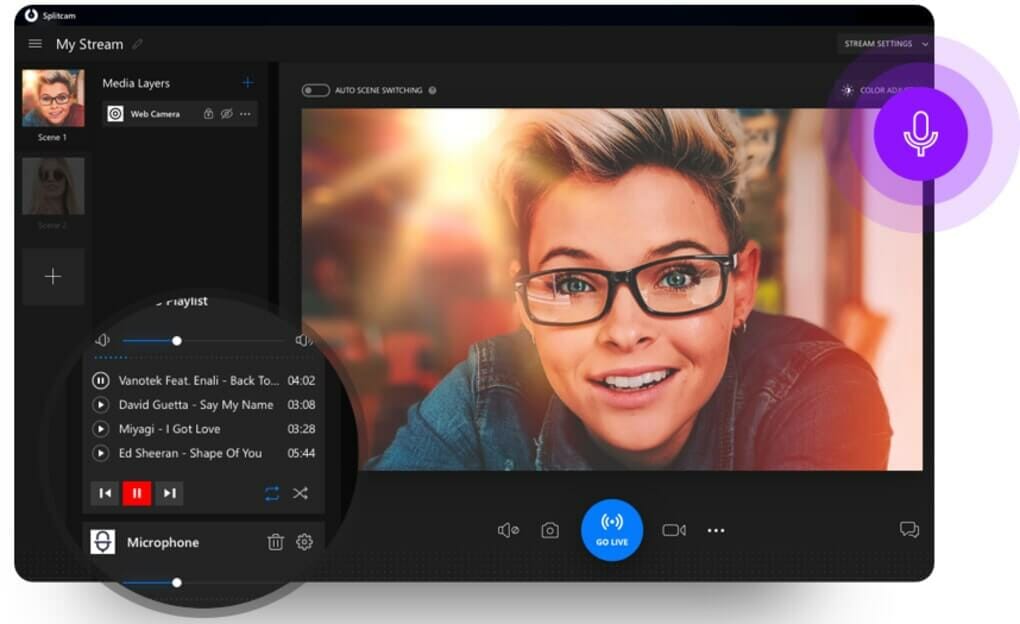

If you are looking for a Restream alternative that is geared more towards multi-source streaming and switching, SplitCam may be an option for you.
This software offers a variety of features for professional broadcasters, including video splitting and source switching. SplitCam can handle streams with a wide variety of resolutions, including high-definition streaming.
When comparing SplitCam vs. Restream, many people prefer SplitCam as a more economical free more economical alternative. Although Restream has a free version, it’s missing many key features that SplitCam offers. It also works seamlessly with many of the top streaming platforms and services.
Here are some more ways SplitCam is different from Restream:
- SplitCam has good video monetization options as compared to Restream
- It works on Mac and Windows
- SplitCam has limited support, such as FAQ sections, webinars, tutorial videos, and phone support.
11. StreamYard
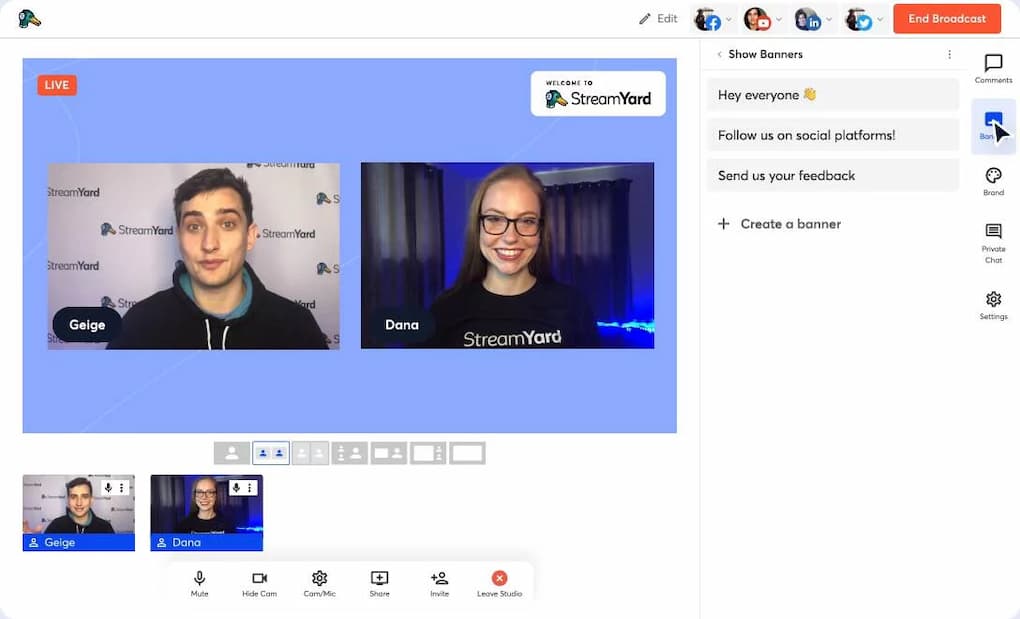

Next, let’s compare Restream vs. Streamyard. StreamYard currently supports fewer platforms than Restream, but it is still a popular alternative. To be more specific, StreamYard only supports Twitter, LinkedIn, Facebook, Youtube, and Twitch, whereas Restream supports over 30 platforms. That said, you can stream to any destination that supports RTMP with StreamYard, which gives it an edge over Restream. It also offers overlays, logos, and backgrounds. You can also record your live streams for up to 50 hours.
One thing StreamYard has a reputation for is its very intuitive dashboard. In comparison, Restream’s dashboard is a bit more complex. That can be very handy for new streamers who value engagement through chat.
As for unique features, StreamYard allows you to do a giveaway and choose a random commenter to win a giveaway prize as a way to encourage engagement.
Here are some more ways StreamYard is different from Restream:
- Its audience analytics feature isn’t as great as Restearms’, so you can’t monitor your performance
- It allows limited users per live stream, so you have to have a small team (ideally less than ten users) of editors and moderators behind the scenes
- It doesn’t offer 24/7 live support.
Pricing:
StreamYard offers a free trial but there is no information available on the website regarding the pricing plans. You have to contact the sales team for further information.
StreamYard has changed its pricing plans as of late 2024. Here are the annual prices and what they include:
- Core: $431.88/month with unlimited viewers, streaming, and local recording, 2 seats, 3 multistreaming destinations, and more.
- Advanced: $827.88/month with unlimited viewers, streaming, and local recording, 4 seats, 8 multistreaming destinations, and more.
- Teams: $2,867.88/month with unlimited viewers, streaming, and local recording, 10 seats, 8 multistreaming destinations, and more.
StreamYard also offers enterprise plans that are priced on a case-by-case basis.
12. Mobcrush


Mobcrush is a free app that lets you stream to Facebook, Twitch, YouTube, and Trovo simultaneously.
A common reason people choose Mobcrush over Restream is for the ability to stream to Facebook gaming pages and Facebook groups for free. You’ll need to become a premium user to do that on Restream. Mobcrush is more geared towards mobile gaming content exclusively, whereas Restream has many more use cases.
Something to keep in mind when comparing Mobcrush vs. Restream is that Restream has more bandwidth than Mobcrush. OBS Studio users should be aware that there are some complaints online about 5-20 second long drops when streaming with Mobcrush using OBS Studio in particular. However, it’s said to have improved over the last couple of years.
With all that said, again, a major positive about Mobcrush is that it’s completely free to use. So there’s no harm in giving it a shot and seeing how you like it.
You can also use it to generate revenue through sponsored streams. It’s also possible to get a unified view of all your chats in one feed, making it easy for streamers. This Restream competitor also automatically creates clips of your best plays so you can replay them during your stream.
13. OneStream


OneStream is another Restream alternative that allows you to go live on over 40 social media platforms simultaneously. It also allows you to schedule pre-recorded videos and streams up to 60 days in advance. Similar to Restream, it requires no software installation.
People consider OneStream vs. Restream because OneStream is about 2x cheaper to use your own branding and 5x cheaper to stream pre-recorded videos. It’s also a great Restream alternative for those with a smaller stream. However, it does not allow split-screen functionality as Restream does.
Here are some more ways OneStream is different from Restream:
- OneStream supports 1-10 users
- You can’t link multiple camera feeds in OneStream
- It doesn’t support split-screen/multi-screen live streaming
- The platform often glitches when sharing live streams on Facebook
- OneStream works on desktops with Windows, Mac, Linux, Chromebook, Android devices,iPad, and iPhones.
Pricing:
OneStream has four pricing plans, including:
- Free
- Basic: $12/month
- Standard: $32/month
- Professional: $39/month
- Enterprise: $83/month
All plans offer a 5-day free trial, and the prices quoted are if you pay monthly. You can also purchase add-ons separately.
14. Vimeo


Vimeo is a platform tailored for professional live streaming and video hosting. It has high-quality streaming capabilities and is widely used by businesses, educators, and content creators who prioritize video quality and feature-rich streaming. It has a large array of features to enhance live broadcasting including custom branding, advanced privacy controls, and detailed analytics.
Here’s how it’s different from Restream:
- Single-Platform Focus: Vimeo focuses on high-quality streaming to a single destination, unlike Restream, which supports multistreaming to over 30 platforms.
- Advanced Privacy Controls: Vimeo offers robust privacy settings, ideal for internal business communications and private events.
- Video Hosting: Beyond live streaming, Vimeo provides extensive video hosting services, including on-demand video storage and playback.
- Custom Branding: Vimeo allows for more customization in terms of player branding and video embedding.
- Enterprise Solutions: Vimeo caters more to enterprise-level clients with comprehensive service packages and dedicated support.
Pricing:
Vimeo offers basic video hosting plans that are suitable for content creators and startups.
Pricing if billed monthly, is as follows:
- Free: $0/month; 1 GB storage, creation and editing, screen recording
- Starter: $20/month; 100 GB storage, auto closed captioning, custom URLs and video player, privacy tools
- Standard: $41/month; 1 TB storage, engagement and social analytics, AI script generator, teleprompter, brand kit
- Advanced: $108/month; 5 TB storage, stream to multiple destinations, host live broadcasts and webinars, AI-generated chapters and text summaries
- Enterprise: Custom pricing; more storage and bandwidth, advanced AI capabilities, quality events, dedicated support
Vimeo OTT:
- Vimeo’s OTT solution is priced separately from the regular Vimeo packages. There are two plans: Starter and Enterprise.
- Starter Pricing: $1/subscriber per month (or 10% of one-time purchases)
- Enterprise Pricing: Contact sales
- This OTT-specific pricing package comes with the Vimeo.com relationship. These plans include all the basics for starting your web-based OTT channel, as well as growing your OTT business online.
For more details, check out our comprehensive guide to Vimeo Livestream pricing.
All plans are billed annually.
15. Be.Live


Be.Live is an intuitive live-streaming platform designed to enhance audience engagement and simplify the broadcasting process for content creators, businesses, and influencers. Known for its user-friendly interface and interactive features, Be.Live is an excellent choice for creating professional live streams with minimal technical expertise.
Be.Live provides a straightforward and engaging streaming experience, making it a strong contender for those seeking a highly interactive and easy-to-use platform.
How it’s different from Restream:
Focus on Interactivity: Be.Live emphasizes interactive features like live polls, Q&A, and on-screen comments to engage viewers actively.
- Built-in Production Tools: Offers built-in production tools such as custom branding and split screens without needing external software.
Browser-based Streaming: Be.Live operates entirely in the browser, eliminating the need for software downloads and simplifying setup.
- Guest Invitations: Easily invite guests with a single click, making it perfect for interviews and collaborative broadcasts.
- Limited Platform Support: Primarily supports streaming to Facebook and YouTube, unlike Restream’s extensive platform integration.
Pricing:
- Starter: $15.83/month billed annually at $190
- Pro: $36.66/month billed annually at $440
- Growth: $45.83/month billed annually at $550
When to Use Restream Alternatives
Restream is powerful software, but, sometimes, using Restream competitors is a better choice.
Although Restream is a top-rated platform for multistreaming and centralized chat, its free version is limited compared to other free versions. Restream pricing is also a bit higher for specific features when compared to other platforms. For example, if the ability to remove the branding is essential for you, there are cheaper options than Restream that you can use. In the same way, if streaming to Facebook business pages or if Facebook gaming is crucial for you, there are free alternatives.
Another reason to consider a Restream alternative is if you are new to broadcasting and have elementary needs. For example, if you’re solely interested in launching a live game stream on Facebook, Mobcrush may be a better and free alternative.
Lastly, compared to many Restream.io competitors, many people consider Restream more harder to do business with.
FAQs
1. Is there anything better than Restream?
Yes, there are several platforms that are comparable to or better than Restream. Some of them include:
- Wirecast
- Switchboard Live
- Castr
- Splitstream
- Prism Live Studio
- Mobcrush
- Streamlabs OBS
- Resi
- Videolinq
- BoxCast
- SplitCam
2. Is Castr better than Restream?
Yes, Castr is a much more comprehensive and powerful platform than Restream. While Restream offers multistreaming features, Castr does so too. But that’s pretty much all that Restream provides. Instead, Castr has video hosting and distribution features that enable you to host on demand video content. You also get live streaming features.
3. What is the best multistreaming service?
Some of the best multistreaming services that you can choose from include:
- Dacast
- Restream
- Wirecast
- Switchboard Live
- Castr
- Splitstream
- StreamYard
- Mobcrush
- OneStream
- Resi
- Streamlabs OBS
4. Is there a free version of Restream?
Yes, Restream does offer a free forever plan where you can multistream to 30+ platforms and can have up to 6 on-screen guests in your stream. The multistreams can all be in HD and 720p resolutions and you can stream to two channels at a time. You also get the option to upload pre-recorded videos of up to 15 minutes for multistreaming.
5. Which is better: Restream or StreamYard?
While StreamYard is more popular than Restream, it has fewer features to offer than the latter. In fact, Restream enables you to multistream to over 30 destinations. On the other hand, StreamYard makes it possible to multistream to just a handful of platforms like Facebook, YouTube, and Twitch. However, StreamYard is well-known for its dashboard that’s quite user-friendly. So, if you’re looking for a wider reach, choosing Restream is a no-brainer. But if ease of use matters more to you, StreamYard is the better one.
Conclusion
As we’ve outlined, there are many alternatives to Restream. Regarding the differences between Restream and Dacsat specifically, the two platforms work seamlessly together. Many Dacast users opt to simulcast on Restream or its alternatives, including the ones we’ve outlined, for greater simulcasting capabilities.
Dacast is a professional-grade and comprehensive video hosting platform that can boost your video broadcasting efforts. Dacast comes with a robust and rich array of features including the ability to host, monetize, and broadcast. And with 24/7 support, you’ll always get the help you need to set up your top-class video streaming.
You can try Dacast and all its features free for 14 days today.

 Connect
Connect
 Events
Events Business
Business Organizations
Organizations Entertainment and Media
Entertainment and Media API
API Tools
Tools Learning Center
Learning Center Support
Support Support Articles
Support Articles